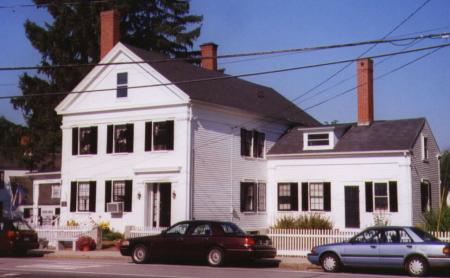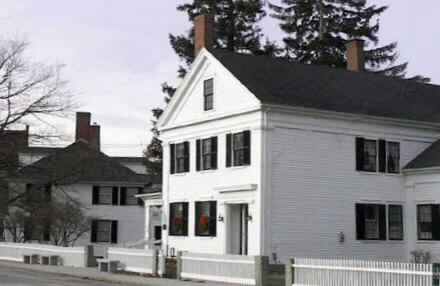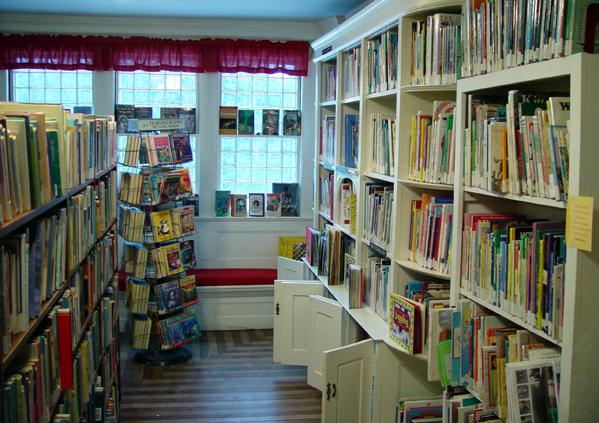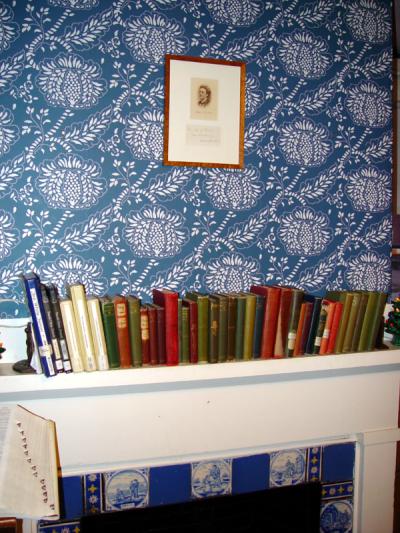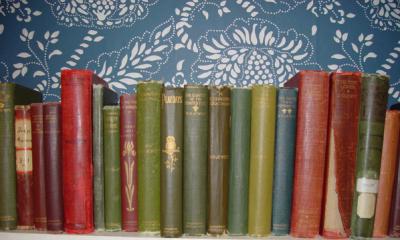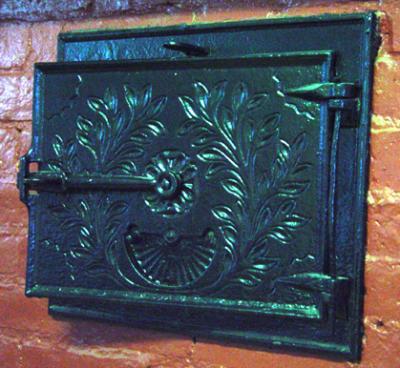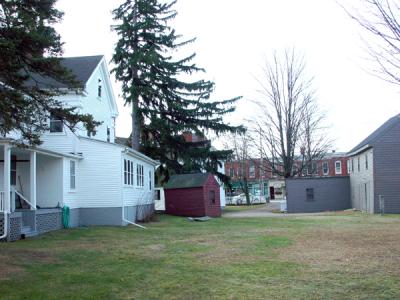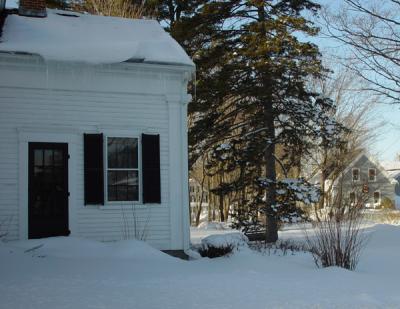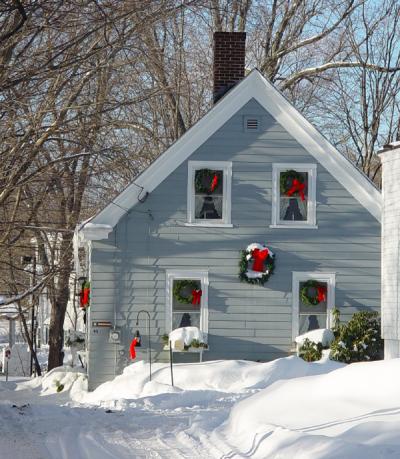The
Jewett-Eastman House:
Home of Sarah Orne Jewett from 1854 to 1887
Sarah Orne
Jewett lived in the Jewett-Eastman House for 33
years, more than half her life, and wrote over 140
works while it was her home. In 1849, when Jewett
was born, her family resided with her grandparents
in the c. 1774 mansion on the corner of Main and
Portland Streets in South Berwick, Maine. Today, we
call this the Jewett House. There Captain Theodore
F. Jewett had lived since the early 1820s, had
raised Sarah's father and uncles, and had become the
town's most prominent shipbuilder and merchant.
After two sons died in the 1840s, Captain Jewett
persuaded Sarah's father, Dr. Theodore Herman
Jewett, to practice his medical profession close by.
For the doctor's growing family, the Jewetts in 1854
built next door on Portland Street the home that
later came to be called the Jewett-Eastman House.
The Greek
Revival home, where Sarah grew up with older sister
Mary and younger sister Caroline, has changed little
over the years. Originally it had no porch. A map of
the 1860s seems to indicate that Dr. Jewett worked
from a small office out-building in the back yard.
By the 1870s, he had moved his practice into the
house, using the newly added porch as an entrance
for his patients. A detached barn stood in the rear,
from which Dr. Jewett may have driven his carriage
on house calls in the country, many a time with
young Sarah at his side.
|
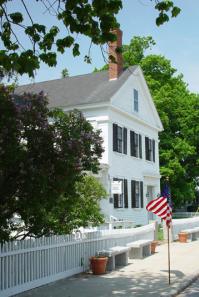
Jewett-Eastman
House
Portland Street
South Berwick,
ME
|
In
this house, as a teenager, the author began her
professional career. She drew upon her childhood here,
the evenings of story-reading by the living room
fireplace with the old Dutch Biblical tiles, her
memories of going to sleep in her second floor back
bedroom, and "waking in my warm bed" to hear "the
sleds creak through the frozen snow as the slow oxen
plodded by." From this house's doorway she had crossed
Portland Street hundreds of times to attend Miss Olive
Raynes' school, and to climb hillside fields to
discover a bubbling spring or a sentinel pine.
South
Berwick in the 1850s and 1860s had become a textile
mill town, and its pre-industrial village, a little
commercial center with a variety of shops and
elm-shaded streets, was the Jewett girls' universe;
uncles, aunts, cousins and playmates welcomed them
from doorways up and down dusty Portland and Main
Streets. The family's Congregational church and
several others stood nearby. Beyond lay the Salmon
Falls River, and up the hill stood Berwick Academy,
where Sarah walked to high school classes,
graduating in 1865, as her father had before her.
One can imagine this young woman, not yet twenty,
mailing her first magazine manuscripts at a post
office housed in a storefront across the street from
the room where she wrote them. In 1868 she got word
that her first story was published, "Jenny Garrow's
Lovers," a tale of unrequited love.
The
character of this South Berwick childhood surely
shaped her writing, but so likely did the threats to
this village way of life. The neighborhood
surrounding the Jewett compound underwent profound
changes in Sarah's twenty-first year. First the
Cummings shoe factory and housing complex sprang up
on Norton Street behind the Jewett homes. Then on
Main Street a quaint row of shops right outside the
family's windows was replaced by a brick commercial
block following a devastating fire in July 1870.
These abrupt transformations signaled the rural way
of life Jewett had known would soon disappear, just
as had the seafaring of her grandfather's day. That
this upheaval sealed her literary ambition is
unproven, but as the young author developed both
friends and readers in Boston -- and matured under
editors like James T. Fields and William Dean
Howells of The Atlantic Monthly -- her
writing began to satisfy them all by capturing the
vanishing details of rural Maine for readers of
urban and industrialized America.
In 1877
Jewett published Deephaven, a collection of
sketches she'd begun during the year of the fire.
She continued to produce a stream of stories,
novels, poems and essays from her childhood home on
Portland Street, most notably A Country Doctor,
inspired by her father. He died in 1878, and her
younger sister married the same year, but Sarah and
her sister Mary remained in the house with their
mother Caroline. Jewett's literary friendships also
led her into the Boston cultural establishment,
where in time she spent much of the year. An easy
train ride connected the world of Charles Street and
Beacon Hill with that of South Berwick village.
|
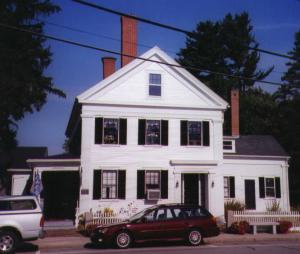
Dr.
Theodore Jewett's office
probably was at the back of the left
veranda. (th)
|
Meanwhile the Jewett House, next door on the corner,
had become, since Captain Jewett's death in 1860, the
residence of Dr. Jewett's brother William. When he
died in 1887, Sarah and Mary Jewett moved with their
mother into the mansion, and sister Caroline and her
husband Edwin Eastman returned to the smaller house
with their eight-year-old son Theodore. The rear of
the Jewett-Eastman House seems to have been expanded
at that time. By now, Sarah Jewett's reputation was
international. The two Jewett houses in the center of
South Berwick had become the town's most celebrated
residences, receiving visits from John Greenleaf
Whittier, William James, Sarah Wyman Whitman, Julia
Ward Howe, Willa Cather, Rudyard Kipling, Madame
Therese Blanc and other prominent intellectual figures
of America and Europe.
Details of
the Jewett-Eastman property continued to thread
themselves through her stories. "A Neighbor's
Landmark" begins: "The timber-contractor took a long
time to fasten his horse to the ring in the corner
of the shed..." We can wonder if in 1894 the author
wrote while looking out her Jewett House bedroom
window at the ring fixed to the corner of a shed
behind the Jewett-Eastman House.
Though Sarah
Orne Jewett died in 1909, Mary remained in the
Jewett House until 1930. Dr. Theodore Eastman, a
physician like his grandfather, upon his death in
1931, bequeathed both properties to the Society for
the Preservation of New England Antiquities (SPNEA).
From 1931 to
the present day, the Jewett-Eastman House has been a
community center for the town of South Berwick -- at
different times a tea room, a gathering place for
bridal showers and other festivities, and a meeting
hall for such organizations as the South Berwick
Woman's Club, the South Berwick Rotary, and even a
1950s group called the Sarah Orne Jewett Garden
Club. In 1971 volunteers organized South Berwick
Public Library on the first floor of the house. When
SPNEA put the property on the market, the
Jewett-Eastman Memorial Committee was incorporated
and raised funds to buy the building in 1984, SPNEA
retaining historic preservation covenants. Today we
can enjoy the architectural details remaining from
Jewett's day - the tiled fireplace, the dining room
cupboards, the author's signature scratched on the
window glass. Even now, with computers in many rooms
and trucks rumbling past the white picket fence, the
identity of the house is mingled with the memory of
Maine's beloved author.
Wendy Pirsig
Jewett-Eastman Memorial Committee
South Berwick, Maine
2004
Note
After 2004, the Jewett-Eastman house was acquired
by Historic New England and incorporated into the Sarah Orne Jewett Museum and Visitor
Center, changing from the South Berwick town
library to a visitor center.
|
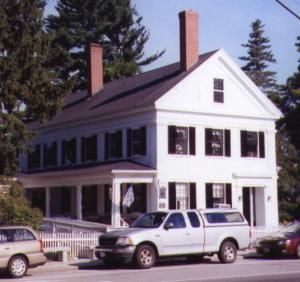
Arron
Sturgis, building historian, believes that the
porch on the left and the doctor's office at the
end of the porch were added after the original
construction. Local maps suggest the
addition was completed before 1872.
(th)
|



